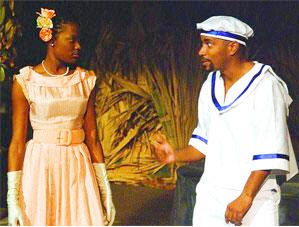Home Page
Free Newsletter
What's New
eCatalog
Audio Clips
Reviews
To Order
Payment Options
Shipping Info
Search
Profiles
About eCaroh
Things Caribbean
| The Orisa in Pan - Ogun Iyan-As In Pan Rhea Simone Auguste
There has been a long-standing debate over the origin and history of the steelpan with traditionalists arguing that Winston Spree Simon invented the pan while many pioneers contend that Simon may have mastered the art of playing a steelpan but he was not the inventor. Several plays have surfaced over the years highlighting specific pan-related incidents or celebrating the life of pioneering pannists, I think an ideal example of this is Errol Hill's Ping Pong which gave an intimate portrait of life in a panyard and was dedicated to "Ellie Mannette and all those early 'pan-beaters' who, out of adversity and in the face of opposition, created a new type of music." Ogun Iyan-As in Pan, the University of the West Indies Centre for Creative and Festival Arts (CCFA) latest production which debuted at the Scherzando Pan Theatre in Curepe on March 24 was written by CCFA director and local playwright Rawle Gibbons and directed by Louis McWIlliams. The play covers from 1939 to 1950; a time when middle-class and upper-class whites feared the possibility of a mass black uprising and a large gathering of blacks was viewed with fear and loathing. Gatherings, whether of a religious or festive nature, were banned and instruments involved in such gatherings were subsequently banned, including African drums; the instrument of African ancestors and a staple in Orisa celebrations. The need for cultural expression could not be suppressed and percussion bands made of bamboo joints or "Tamboo Bamboo" bands were then formed. During World War II, even the Tamboo Bamboo bands were banned by the British Colonial Government but out of a primal need for music, discarded oil drums soon became the source of musical experiments. Orisa thus shares a similar past to that of the steelpan having been banned with followers searching for innovative ways to carry on the religion. Both the religion and the instrument are representative of a disposessed race and both are symbols of determination in the face of adversity. The corner of Scherzando panyard was transformed into a complex set which incorporated elements of an Orisa palais complete with flags representative of the different orisha with the meat of the story taking place beneath the moonlit sky and against a backdrop of painted galvanise. Staging the play in the open air was quite risky but the risk paid off for not a single dark cloud marred the sky and the outdoor setting actually enhanced the production and gave credulity to the characters. Both amateur and experienced actors made up the cast of this production and although the amateurs could easily be distinguished from the experienced, I found that the lack of polish made their performances more authentic for they essentially brought to life the gritty reality faced by musicians and panmen in particular at that time. Drummer par excellence Andrew Beddoe's nephew Jeffrey Beddoe (Cutter) as well as Paul Massey (Kanga), Darryn Peters (Bem Beh) and Anthony Frederick (Bull), collectively known as The Dry River Boys, delivered stellar performances and their live music pieces certainly struck the right chord with the audience. Kudos to musical director Harold Headley for I found the musical selections to be well-chosen and definitely well-rehearsed. The play was built around the distinctive qualities and sound of the steelpan and the quality of the musical performances in this play was exceptional. The dance movements in the play (primarily based on movements associated with Orisa followers) as well as the colours used for costuming (particularly the pink associated with Oshun) would not have been fully appreciated nor understood without a fore-knowledge of Orisa and the complex beliefs and rituals associated with the religion. That aside, the aesthetically pleasing qualities of these production elements compensates for any lack of understanding of the religion. Source: Trinidad Express |



